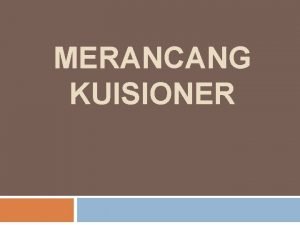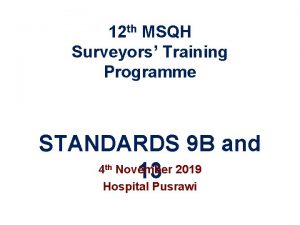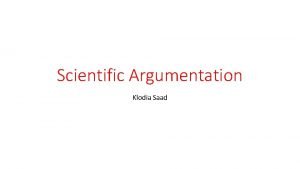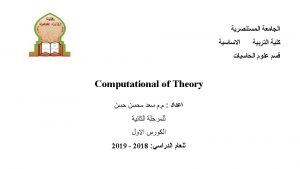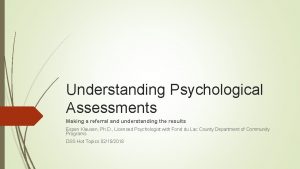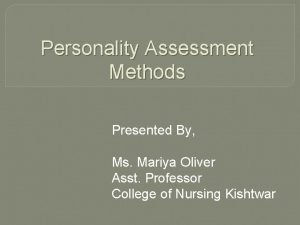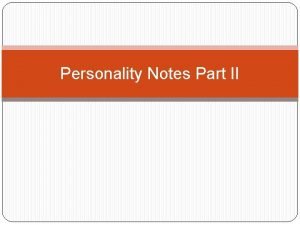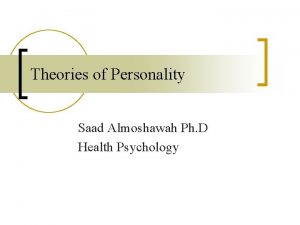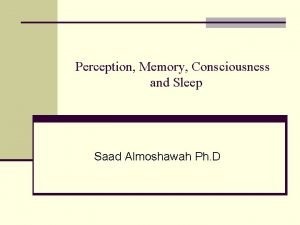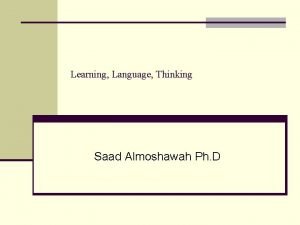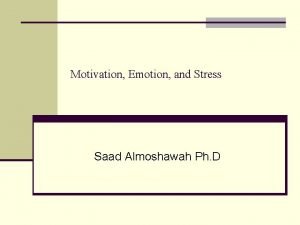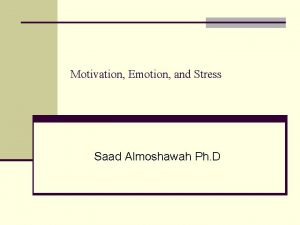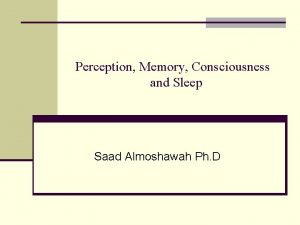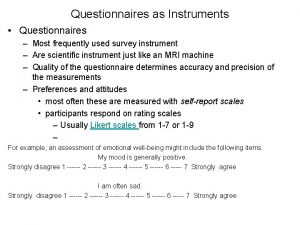Personality Assessment Dr Saad Almoshawah n Personality questionnaires





























- Slides: 29

Personality Assessment Dr. Saad Almoshawah

n Personality questionnaires are much favoured by psychometrists as instruments for measuring personality. n because it is relatively simple to construct reliable tests and to establish norms n In brief it is possible to make questionnaires psychometrically efficient. n It’s noticed that no mention is made of validity.

n The demonstration of the validity of any personality test is difficult from the nature of the variables involved. n there are psychometrically powerful personality tests with little evidence of validity. n Some psychometricians, indeed, ignore the problems of validation. n They resort, in fact, to classical test theory.

problems with personality questionnaires n The problem of the variables to be measured. n Items : The difficulty with items is that, no matter how skilled the item -writer the items are inevitably simplistic. n It is impossible to catch the rich subtlety of human feelings in brief statements. n The response set of social desirability This is the tendency to endorse items depending upon how socially desirable it is to do so. n Response set of using the middle or 'uncertain' category Where "here is a middle category, denoting uncertainty of response, this proves for certain subjects fatally attractive.

problems with personality questionnaires n The response set of using the extreme response. n Face validity of items In tests of ability an item is largely self-evident provided that the instructions are clear. n Sampling the universe of items. n Sampling subjects : the problems of sampling subjects in connection with the standardisation of tests. n Problems in establishing the validity of personality tests.

TYPES OF ITEM n The yes — no item n The true — false item n The like-dislike item n Items with rating scale

The nature of items Angleitner etal. (2004) carried out systematic investigations of the content of items in some well known personality questionnaires. These authors classified content in a number of ways: n 1. description of reactions which could be overt, covert or bodily reactions; n 2. trait attributions which might be unmodified or modified by situational constraints; n 3. wishes and interests; n 4. biographical facts; n 5. attitudes and beliefs; n 6. reactions of other persons; n 7. bizarre items.

List of Test n The Californian Psychological Inventory (CPI) (Gough, 1975) n Age range 13 years and above. n Norms Means and standard deviations of a variety of groups. n Variables measured Eighteen variables are measured by the CPI. n Do : dominance. Sy : sociability. n Sa : social acceptance. Re : responsibility. n Sc: self control. Gi good impression. n Ac : achievement via conformance. n Ai : achievement via independence. n Ie : intellectual efficiency.

n n Py : psychological mindedness. Cs : capacity for status. Sp : social pressure. Wb : sense of well being. So : socialisation. To : tolerance. Cm : communality. Fx : flexibility. Fe : femininity. n Reliability Test-retest reliability varies from. 55 to. 75, after 1 year. This suggests a reasonable stability. n Validity Essentially construct validity, arising from the large numbers of studies conducted with this test, but see discussion under Comments. n Item type Statements to be answered true or false. Number of items 480.

Clinical Analysis Questionnaire (CAQ) (Krug, 1980 a) n Age range 16 years upwards. n Sex differences Yes, but separate norms. n Norms The CAQ is essentially a test for use with clinical patients. It contains norms for normals and for 'clinical adults and adolescents' which consist of a mixture of patients with various psychiatric diagnoses. n Variables measured Two sets of variables are measured by the CAQ. n Firstly, the sixteen factors of the Cattell 16 PF test. These are described and discussed below in our discussion of the 16 PF. They will be simply set out here

Clinical Analysis Questionnaire (CAQ) (Krug, 1980 a) n A. Warmth, n n n E. Dominance. H. Boldness. M. Imagination. Q. Radicalism. Q 4. Tension. Secondly, these twelve clinical factors: Dl. Hypochondriasis. D 2. Agitation. D 3. Suicidal depression. D 4. Anxious depression. D 5. Guilt and resentment. Paranoia. Schizophrenia. Psychological inadequacy.

Clinical Analysis Questionnaire (CAQ) (Krug, 1980 a) n D 6. Low energy depression. D 7. Boredom and withdrawal. Pp. Psychopathic deviation. As. Psychasthenia n C. Emotional stability. G. Conformity. L. Suspiciousness. 0. Insecurity. Q 3. Self-discipline. n B. Intelligence. F. Impulsivity. I. Sensitivity. N. Shrewdness. Q 2. Self sufficiency.

Clinical Analysis Questionnaire (CAQ) (Krug, 1980 a) n Reliability The median internal consistency reliability (alpha) of the scales is. 6 although it is claimed that the reliability of the factors in Part 2 is higher than this. n Test-retest reliability is generally also higher than this. These reliabilities are lower than is desirable but are just about adequate for use of the CAQ with individuals rather than groups.

Comrey Personality Scales (Comrey, 1970) n n n Age range 16 -60 years. Sex differences Yes. Norms 365 males and 362 females, all volunteers. No other information in manual. Variables measured Eight personality dimensions and two validity scales: Trust vs. defensiveness. Social conformity vs. rebelliousness. Emotional stability vs. neuroticism. Empathy vs. egocentrism.

Comrey Personality Scales (Comrey, 1970) n Orderliness vs. lack of compulsion. Activity vs. lack of energy. Masculinity vs. femininity. Extra version vs. intra version. n In addition there is the V scale, measuring consistency of response, and a measure of social desirability response bias. n Reliability Split-half reliabilities (corrected by the Spearman-Brown formula, as described in Chapter 1 of this handbook) for the personality scales were all beyond. 9 except for the masculinity scale (. 87). These reliabilities are highly satisfactory.

Comrey Personality Scales (Comrey, 1970) n Validity Comrey has made considerable efforts to n n n demonstrate the validity of these scales, but see Comments. Item types Statements to be answered on seven-point rating scales: Always Never Definitely not. Number of items 180.

Edwards Personal Preference Schedule (Edwards, 1953, first edition) n Age range 18 years upwards. n Sex differences See Comments. Norms There are norms, but see Comments. n Variables measured Fifteen variables are measured, based upon Murray's (1938) needs: achievement, deference, order, exhibition, autonomy, affiliation, intraception, succorance, dominance, abasement, nurturance, change, endurance, heterosexuality, aggression. n Reliability Satisfactory but see Comments. n Validity Little evidence for validity but see Comments.

n Item type Forced choice (2) items. Subjects have to say which of two statements is the more characteristic of them or which they enjoy the more. n Number of items 225. Time for completion One hour.

Eysenck Personality Questionnaire (EPQ) (Eysenck and Eysenck, 1975) n It should be noted that I shall discuss this version of the test, although there is a more recent one, the EPQR. This is because so much research has been carried out with the EPQ (and there are extensive normative data) that the meaning of the scales and scores is particularly clear. Furthermore the psychological meaning of the EPQ variables should be identical to those of the new version, if it is equivalent. If it is not, then new studies with the test will have to be carried out. The one major claimed point of difference between the two tests will be discussed where relevant.

Eysenck Personality Questionnaire (EPQ) (Eysenck and Eysenck, 1975) n Age range 16 years upwards. There is a version of the test suitable for children, the JEPQ, which can be used with children of 11 and upwards. n Sex differences Yes, but separate norms. n Norms Large number of occupational and abnormal groups, age norms and a general sample of more than 5000 subjects. n Variables measured Three variables are measured, those claimed by Eysenck to be the most important personality dimensions (e. g. Eysenck, 1967): E. Extraversion; N. Neuroticism; P. Psychoticism. There is also an L scale to screen out those giving socially desirable responses.

Eysenck Personality Questionnaire (EPQ) (Eysenck and Eysenck, 1975) n Reliability Internal consistencies are all above. 7, many n n above. 8 with the exception of P for normal females, which is just below this. With this exception the reliabilities are highly satisfactory. Test-retest reliabilities, for various groups with the exception of. P are all beyond. 7, many beyond. 9 and thus are highly satisfactory. Validity The validity of these scales is the best supported of any personality measure. This support comes from the extensive experimental work, carried out over the years by Eysenck and colleagues, into the nature of these variables and from numerous factor analytic studies. This evidence will be discussed under Comments. Item type Simple questions to be answered 'Yes' or 'No'. Number of items 90. Time for completion 15 mins.

Minnesota Multiphasic Personality Inventory (MMPI) CHathaway and Mc. Kinley, 1967, the original edition) n Age range 16 years upwards. Although used with normals, there is little variance with such a sample and this test is best used with clinical or psychiatric, abnormal samples. n Sex differences Yes, but separate norms. n Norms Normative groups in test manual and extensive normative data in published literature. n Variables measured The standard MMPI measures fourteen variables but more than 200 scales have been developed from the item pool.

Minnesota Multiphasic Personality Inventory (MMPI) CHathaway and Mc. Kinley, 1967, the original edition) n The standard scales are four validity scales (question, lie, validity and n n n n test taking attitudes) plus ten clinical scales: Hs. Hypochondriasis. D. Depression. Hysteria, Pd. Psychopathic deviate. Mf. Masculinity Femininity. Schizophrenia. Paranoia. Pt. Psychasthenia. Si. Social intraversion. Ma. Hypomania.

Minnesota Multiphasic Personality Inventory (MMPI) CHathaway and Mc. Kinley, 1967, the original edition) n Reliability The reliability of some scales is low. n Validity See Comments. Item types Statements to be answered as true or false. n Number of items 566 but various short forms have been developed. Time for completion 90 mins.

The Professional Personality Questionnaire (PPQ) (Kline and Lapham, 1990 s) n Age range 18 years upwards. The test was designed for n n n graduate personnel selection. Sex differences Eliminated in test construction. Norms Large sample undergraduate norms and some small professional. Reliability Alphas, for the five scales, range from. 70 to. 78. These are satisfactory reliabilities. Item type All items have the following format: 'Ideally I would like to work in a job setting where. . . ' Each item portrays a situation to which subjects have to respond 'Yes' or 'No'. Number of items 68. Time for completion 15 -20 mins.

The 16 Personality Factor Test (Cattell, Eber and Tatsuoka, 1970) n Age range l 6 years upwards. However, it must be noted n n that this test has several variants, designed for younger age groups these are: The High School Personality Questionnaire (Cattell and Cattell, 1969 a) – 12 to 15 years. The Child's Personality Questionnaire (Porter and Cattell, 1963) - 8 to 11 years. The Early School Personality Questionnaire (Coan and Cattell, 1966) - 6 to 7 years. The Pre-school Personality Quiz (Cattell, 1957) - 4 to 6 years.

n I shall give their descriptive titles here. The primary factors n n n are: A. Reserved, detached vs. outgoing, warmhearted (high score on the right). B. Low crystallised intelligence vs. high crystallised intelligence. C. Emotionally unstable vs. emotionally stable. E. Humble, mild vs. assertive, dominant. F. Sober, taciturn vs. happy-go-lucky, enthusiastic. G- Expedient, disregards rules vs. conscientious, persistent. H. Shy, timid vs. venturesome, uninhibited. I Tough-minded, self-reliant vs. tender-minded, sensitive. L. Trusting vs. suspicious.

n M. Practical, down-to-earth vs. imaginative, bohemian. N. Forthright, artless vs. shrewd, acute. 0. Self-assured, secure vs. guilt prone, apprehensive. Ql. Conservative vs. radical. Q 2. Group dependent vs. self-sufficient. n Q 3. Undisciplined, lax vs. self-sufficient, resourceful. Q 4. Relaxed, tranquil vs. tense, frustrated. n These primary factors are correlated and a number of second order factors can be measured: n 1. Intraversion vs. extraversion. n 2. Low anxiety vs. high anxiety.

n 3. Sensitivity, emotionalism vs. tough poise. n 4. Dependence vs. independence. n Most of these variables are measured in the other tests for younger subjects together with factors such as D, excitability and J, active vs. passive, which are only reliably found in children. n Validity Evidence for construct validity (see discussion). n Item type Items are trichotomous, with a warning to use the middle category as little as possible. Some items offer a choice of three responses, others are of the yes, uncertain/inbetween/occasionally, no/never type. n Number of items 187. Completion time 35 -45 mins.
 Contoh angket terstruktur
Contoh angket terstruktur Extensive speaking meaning
Extensive speaking meaning Pisa 2015 questionnaire
Pisa 2015 questionnaire Lecture automatique de questionnaires
Lecture automatique de questionnaires Msqh survey questionnaires
Msqh survey questionnaires Type scale
Type scale Questionnaires about vaal river
Questionnaires about vaal river Klodia saad
Klodia saad Saad ahmed economics
Saad ahmed economics Saad ahmed javed
Saad ahmed javed Dr sadia saad
Dr sadia saad Ryan saad
Ryan saad Kussmaul sign
Kussmaul sign Movie database
Movie database Télégestion saad
Télégestion saad Manufacturing strategies
Manufacturing strategies Joanne saad
Joanne saad Mohsen hassan
Mohsen hassan Salman azhar
Salman azhar Dr hussein saad
Dr hussein saad Saad alshahrani
Saad alshahrani Saad ahmed javed
Saad ahmed javed Sample referral question for personality assessment
Sample referral question for personality assessment The barnum effect in psychological assessment refers to
The barnum effect in psychological assessment refers to Personality assessment methods
Personality assessment methods Assessment of personality notes
Assessment of personality notes Personality assessment definition
Personality assessment definition What is personality assessment
What is personality assessment Documentation portfolio example
Documentation portfolio example Define dynamic assessment
Define dynamic assessment
